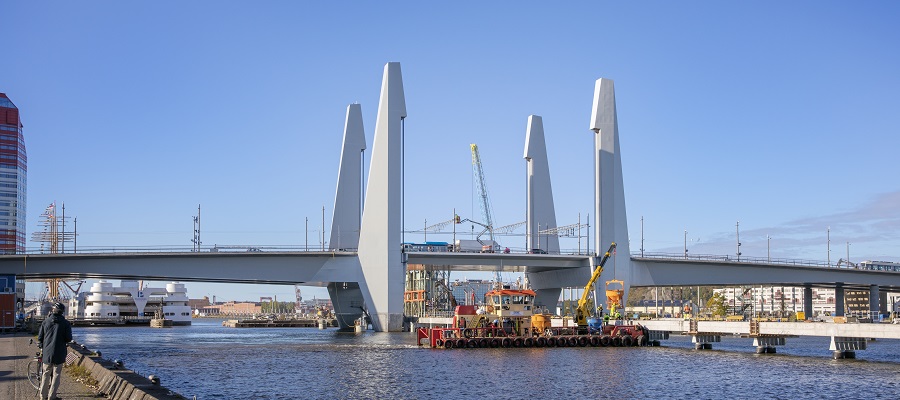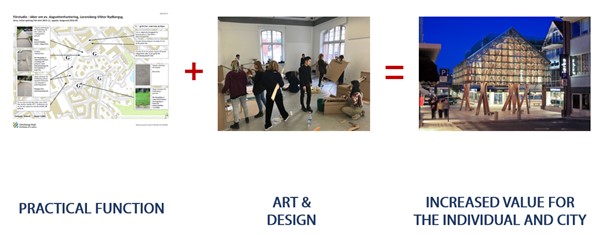
IWA World Water Congress & Exhibition 2022 - Climate adaptation in Gothenburg
The City of Gothenburg takes control of the rain.
We take control of the rain
With our new comprehensive plan rain will shape our urban development.
Extreme rain events can cause serious consequences for Gothenburg, impacting on how society can function and resulting in large cost implications. Then there is the fear that it could happen again. Dare you leave your house anymore? The potential damages have been estimated to cost 15 billion SEK if nothing is done. Subsequently, it has been decided that a systematic approach is needed to create resilience even during extreme rain events. This has also been incorporated into the comprehensive plan.
Knowledge-based processes have been developed to forecast impacts and identify opportunities for flood defense measures, taking into account legal issues, feasibility, cost and organisational systems. This should enable the right information to be delivered to relevant actors/decision-makers. When evaluating feasibility, it is critical to not just focus on economic impacts. Social and environmental values need to be included in the overall assessment. Adaptations to the city should also mean improvements for people and nature, as well as increased security against flooding.
 The mindset is to is to turn something negative into a positive possibility. Picture: City of Gothenburg.
The mindset is to is to turn something negative into a positive possibility. Picture: City of Gothenburg.
New developments are already designed to withstand extreme rain events. However, under the current legislation in Sweden it is difficult to implement resilience measures in existing areas as responsibility is spread amongst many different actors.

The design of Munkebäck park is an example of joint use of stormwater and recreation. Picture: Lo Birgersson. Sketch: City of Gothenburg.
Barriers against risks to raw water
Climate change effects such as heavy rain causes multiple quality risks for drinking water production.

Ultrafiltration in cross-section. Photo: Frank Palm.
Effects of climate change such as heavy rain leads to multiple quality risks for drinking water production, including deterioration of raw water quality due to changes to microorganisms and increased risk of contamination from overflow discharges during extreme rains. Our risk analysis has identified the following as the most severe threats to water supply in Gothenburg:
- Water-borne diseases
- Major interruption to water delivery
A risk analysis was conducted and identified the main threats to be increased risk of pollution, sewer overflow and contaminated runoff due to heavier rainfall and changes to pathogenic microorganisms due to a warmer climate. It was decided that investment in ultrafiltration would be the most effective to manage these risks from both social and economic perspectives.
Installation of ultrafilters significantly reduces the risks to the Gothenburg drinking water supply chain. It provides a separate barrier capable of effectively treating raw water, regardless of the volume of incoming flow. Another advantage is that the effects of the barrier can be safely and continuously monitored.

Virus-like-particles (VPL) before and after UF.
Ultrafiltration is based on size exclusion (at virus scale) which makes it an independent barrier even during suboptimal operation conditions (for example during problems in the precipitation process)
'It is best when there is a need' – it provides a reliable barrier effect even when there is interruption earlier in the process (such as precipitation residual from the precipitation process with cold water, high flows, lack of precipitation chemical, etc.).
The barrier effect is monitored during operation of the ultrafiltration process. It is a robust method that is not impacted by changes to microorganism sensitivity due to warmer climate, for example. The process consumes minimal energy and chemicals.

The ultrafiltration hall. Photo: Frank Palm.
Managing future city flow by predictive control
Model-based control for minimizing discharge through control of CSOs and volumes in existing sewers.
Future City Flow is a Vinnova-financed system to support decision-making which has been developed to represent the network and wastewater treatment works in Gothenburg. Functions include:
- Presentation and collation of historic data
- Real-time monitoring
- Planning tools that enable evaluation of the effects of potential future measures on inflow and infiltration, overflow discharges and wastewater treatment works bypass
The project was officially launched in 2017, although the need for a system that would enable this kind of analysis had been identified long before then. The system is beneficial from both network and treatment works perspectives.
There are many advantages from a network perspective, including:
- Ability to see the impact of larger rainfall events on combined sewer overflow in the immediate aftermath, giving an oversight of how the network responds and where there are problems with capacity. This tool can facilitate prioritization of planned measures as well as providing an overview on the current status for regulatory authorities and the general public.
- Users can use the tool to perform quick tests of different measures and see which give the best results for inflow and infiltration, overflow discharges and wastewater treatment works bypass. This makes it easier to decide which projects to priorities in Gothenburg as well as being able to describe the benefits of the measures to decision makers.
- The planning tool makes it quick and easy for users to combine different measures and make a strategic plan. Within the plan it is possible to make a timeline with all the measures which shows how many projects will be carried out simultaneously and the projected effect on both costs and reduction in inflow and infiltration. Using this tool makes it simple to adjust the time plans for different projects to optimize both annual workload and costs.
- Overflow discharges can be minimized by equalizing flow distribution across the network.
Using Future City Flow enables Gothenburg to test and decide suggestions for future measures more quickly and efficiently, as well as being able to priorities them based on what will give the best results. These measures can be structured into strategic plans outlining forecast effects over time which can be presented to local politicians. This makes our work and priorities more transparent and accessible for businesses, politicians and the general public.


